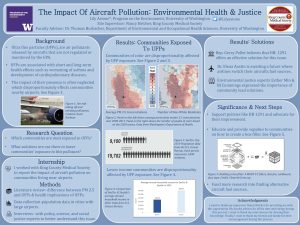The Impact of Aircraft Pollution: Environmental Health & Justice
Ambient air pollution kills millions of people each year. Common sources of air pollution are farms, wildfires, vehicles, factories, etc. One source that is often neglected is pollution emitted from aircrafts. Aircrafts emit a variety of pollutants, the most notable and arguably harmful, is ultrafine particles (UFP). During my internship with King County Medical Society (KCMS), I assessed the impact that UFP have on communities living near large airports. To do this I conducted a literature review to learn about the health effects associated with UFP and found that it is linked to a variety of negative health outcomes. Some of which include, the development of certain cancers and increased hospitalizations for those with cardiopulmonary diseases. I also collected and analyzed population data to see who is most likely to live near large airports and therefore be disproportionally affected by UFPs. It turns out there are significantly more people of color (POC) located near large airports. Finally, I conducted interviews with relevant experts to learn about possible solutions. The first solution is to have aircrafts switch to a less harmful fuel source. The second is to provide affected communities with air pollution reducing technology like HEPA filters. Applying both of these solutions could drastically improve the health of those living near airports. It could also help solve the environmental injustice that is POC being disproportionally affected by air pollution from aircrafts.
